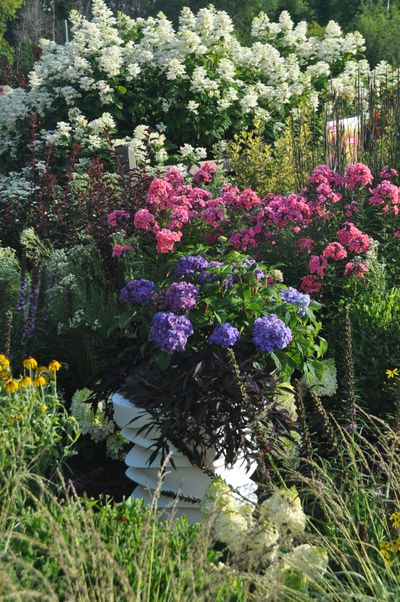Gardening: Hyrdrangeas’ showy blooms rarely blue in Inland Northwest

Hydrangeas are the showy stars of the late-summer garden.
These large shrubs put out equally large sprays of flowers in colors of white, pink, rose and mottled blue. As summer fades, the flowers can be cut and dried to make winter bouquets.
Growing hydrangeas in the Inland Northwest can be a bit of a challenge, however. They need regular irrigation, thrive in part shade and are deer candy.
Many people love the big, bold blue flowers of big leaf hydrangea (Hydrangea macrophylla) that you see on the coast. Unfortunately, this beautiful shrub’s flowers don’t usually stay blue in our gardens.
Big leaf hydrangeas need acidic soil and water with a pH of 5.2–5.5 to produce clear blue flowers. The average pH of our soil and water are in the 6.0-7.0 range. As a result, hydrangeas tend to turn a mottled blue to pink over time.
Soils can be amended with conifer bark and compost and fertilized with rhododendron fertilizer or aluminum sulfate increase soil acidity, but our more alkaline irrigation water may override our efforts to still produce flowers in shades between blue and pink.
Another challenge is that big leaf hydrangeas blooms on wood that grew the previous summer and over winter on the plant.
While the plants are hardy to USDA Zone 5, the overwintering flower buds are hardy only to Zone 6. This means that when we get a harsh winter like last winter, the plant will survive but the buds won’t.
Improperly timed pruning will also reduce flower production. Big leaf hydrangeas should be pruned in late August into early September, so the plant has time to set buds for next year. Pruning in the spring removes the buds.
While the big leaf hydrangea might be a challenge to grow, there are several other types of hydrangeas that are much easier to grow here.
No blue flowers, though; their flowers lean toward white, pink or dusty rose. The PeeGee hydrangea (Hydrangea paniculata ‘Grandiflora’) is hardy to Zone 3 and produces buds on this year’s wood so it isn’t affected by winter cold. The plant produces creamy white flowers in late August that age to a light dusty pink over the following weeks. It is a vigorous grower that can grow to 10 feet tall and wide.
The Annabelle or snowball hydrangea (Hydrangea arborescens “Annabelle’) is also hardy to Zone 3. It produces huge white blooms in June and July that can reach 8 inches in diameter and resemble – what else? – giant snowballs.
Like the PeeGee hydrangea, the Anabelle produces buds on this year’s wood and can grow to a respectable 4 to 5 feet tall and 3 to 4 feet wide. Because the flowers bloom on new wood, the plant can be pruned hard in early spring.
All the hydrangeas benefit from an even moisture supply and afternoon shade. They need well-drained soil rich in organic matter topped with 2 to 3 inches of mulch to retain soil moisture.